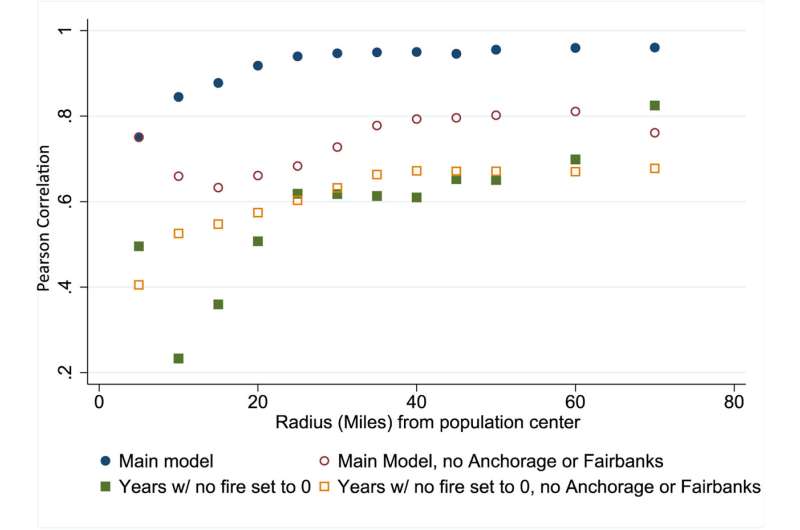This article has been reviewed according to Science X's editorial process and policies. Editors have highlighted the following attributes while ensuring the content's credibility:
fact-checked
trusted source
proofread
Wildfire proximity associated with asthma cases in rural Alaska

Alaska is warming twice as fast as the rest of the world, and Penn State researchers are examining the resulting impacts, such as wildfires, and how they are linked to health conditions like asthma. In a new study, they found that wildfires are associated with asthma prevalence, and the association is strongest within 25 miles of fires.
Climate change is increasing the number of wildfires in rural Alaska, and incidents of asthma among the state's residents are increasing, said Luke Smith, assistant research professor in the Social Science Research Institute's Computational and Spatial Analysis Core (CSA).
"We know that increases in asthma cases are being driven by exposure to small particulate matter generated by wildfires, but it's unclear how far reaching these impacts are," Smith said.
Fine particulate matter is associated with significant risks to human health, including asthma. Because wildfires can distribute fine particulate matter thousands of miles, it is important to study the relationship between proximity to wildfires and asthma in rural locations where particulate matter cannot be easily measured due to limited monitoring instrumentation.
To measure the relationship, the researchers examined the effects of wildfires on new asthma case counts in the 11 Alaska Behavioral Health System (BHS) regions from 2007 through 2017 using mapped wildfire boundaries and population center data from the Alaska Bureau of Labor and Statistics. To be included in case counts, respondents answered yes to questions about being diagnosed by a doctor as having asthma and current asthma symptoms.
The researchers then looked at Behavioral Risk Factor Surveillance System (BRFSS) survey data, which identified the percentage of people over age 18 with asthma, and United States Census data from other rural areas in the U.S.
"We found that 9.9% of Alaskans have asthma, higher than the national average of 7.8%," said Smith. "We also found that wildfires are associated with asthma prevalence, and there is a very strong positive correlation within five miles of wildfires."
The researchers also found that new cases of asthma decreased the further away participants were from wildfires.
"Beyond 25 miles, the correlation between asthma and wildfires was relatively flat. We also found that yearly exposures to wildfires resulted in higher annual asthma rates," Smith said.
The work appears in The Journal of Climate Change and Health.
Smith, who is also an environmental epidemiologist interested in the effects of climate-driven exposure on a variety of human health outcomes, was gratified by the success of the project.
"At the start of the study, I wasn't sure if we would be able to establish a relationship between asthma prevalence and wildfires without high level instrumentation to measure particulate matter," he said. "We were able to create an exposure metric based on simple proximity to fires in rural areas and add further evidence to the body of literature connecting wildfire smoke to asthma."
The research team's work has important implications for wildfire management agencies and for policy makers who must address health issues associated with wildfires, especially in rural areas.
In the future, the researchers said, they would like to connect their findings to individual level data obtained through other sources, such as insurance claims and hospital admittance records.
"Since there isn't a lot of work being done connecting wildfires to asthma cases in rural areas, it might be useful to reinforce the idea that data measurement of pollution is important even if the area isn't highly populated," said Smith.
Co-author Guangqing Chi, professor of rural sociology, demography and public health sciences, CSA director, and Social Science Research Institute cofunded faculty member, noted that climate change consequences, including the increasing frequency and magnitude of wildfires, are threatening human health and well-being.
"Significant efforts from academics and across human society are needed to tackle this problem," he said.
More information: M. Luke Smith et al, Spatial proximity to wildfires as a proxy for measuring PM2.5: A novel method for estimating exposures in rural settings, The Journal of Climate Change and Health (2023). DOI: 10.1016/j.joclim.2023.100219




















